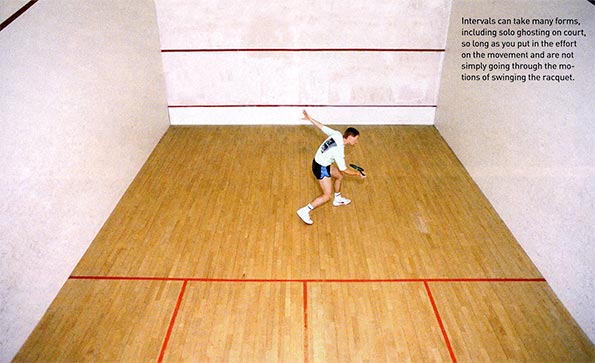Damon Leedale-Brown, Sports Scientist & Conditioning Specialist
In the final article of our 3-part series on interval training I thought it would be interesting to see examples of different types of interval sessions performed by current and former World Class Professional players.
Let’s start with a slightly humorous take on a traditional style of gym-based interval session by Laurens Jan Anjema— current World No. 14:
My ‘favorite’ interval session, if there is such thing, was done on this rusty bike in a shabby gym of an old English squash club in Essex where I first trained as a pro player. This bike was not just a bike—it was a moody old thing. Being the only bike in this very tiny gym, she definitely had character. She even had attitude. The moment you didn’t respect her, or the session you were about to (hopefully) endure, she could definitely surprise you and send doubts into your legs and brain during only your second or third set of many more yet to come.
The unique thing about this machine was that the resistance automatically went up the faster you pedaled. On most bikes the resistance ‘breaks’ when your RPM’s go higher than a certain number. Not on this one. She stayed with you, no matter how hard you pushed! Located opposite a big mirror you couldn’t help but sometimes catch your own eyes during the moment you were suffering most.
During some training phases we did these sessions three times a week: Monday, Wednesday and Friday. It wasn’t rocket-science either: 1-minute intervals on Monday, 45-second intervals on Wednesday, and 30-second intervals on Friday. I was always nervous before the session, and felt like a God once I’d finished them.
My best ever session was on a rainy Monday in 2005. I managed to do 24 sets of 1-minute intervals at 105 RPM’s, which was approximately 380 Watts. After almost an hour on the bike (including warm-up) I climbed off the bike, stumbled to the court-area, lay down behind the stairs and fell asleep almost straight away!
Laurens Anjema is considered physically one of the strongest athletes on the Men’s World Tour, and this insight into the type of interval-based training he was working through on a regular basis during his early years as a pro player goes a long way towards explaining his athletic abilities and mental toughness.

Gilly Lane is the former US No. 2 Men’s player, and after graduation from Penn he pursued a career as a pro player reaching a career high ranking of World No. 48 before recently retiring from the tour. One of Gilly’s preferred styles of interval training sessions was to mix up physical work efforts with solo hitting.
An example of one of Gilly’s sessions:
- Warm up/dynamic stretching
- 50 drives to 3 floorboard target—forehand
- 2 sets of 20 sprints under 1 minute
- 50 drives to 3 floorboards—backhand
- 2 sets of 1 minute ghosts
- Figure of 8 volleys with volley drop—25 drops each side approx
- Bike interval set—4 minute hard effort
- 2 drives and drop forehand—5 minutes
- Treadmill interval set—4 minute hard effort
- 2 drives and drop backhand—5 minutes
- 2 sets of 1 minute ghosts
- 2 drives and 2 wall boast—5 minutes
- Jump rope—3 sets of 1 minute
- Drops to target forehand—30 targets
- 2 sets of 1 minute ghosts
- Drops to target backhand—30 targets
Gilly found this style of session helped to break up the monotony of a 40-minute solo hitting session by mixing in the physical intervals, and also challenged his ability to maintain the consistency and accuracy of his strokes as he became more fatigued from the physical work.
I regularly use variations of this style of skills and physical interval session within my training with players and find it a great way of bringing competition into group sessions with players either working individually or in pairs. A couple of examples are:
Solo:
- 10 drives to a 4- floorboard target area
- 5 T-Line Runs—accelerate from T-line to front of court and touch top of tin with both hands (using a lunge motion), backpedal to T-line and get at least one foot behind line = 1 rep
- 50 Jump Rope
- Complete 4 sets of this sequence as quickly as possible aiming to beat your fellow players
- Rest for 2-1/2 minutes then complete on other side
Pairs:
- Drop/Drive—Player at front hits 15 drives into assigned target area
- 6 T-Line Runs
- Drop/Drive—Partner hits 15 drives into target area
- 6 T-Line Runs
- Rotating Drives (rails!) —Players hit total of 30 targets between them
- 20 court sprints
- Repeat entire sequence twice as quickly as possible aiming to be the first pair to complete
- Rest for 2-1/2 minutes then complete on other side
With a group of motivated players these sessions can be extremely competitive! I have generally found they lead to a higher overall level of mental focus and application during the hitting sequences, with players pushing harder during the physical work efforts. I once set up this style of session during consultancy work with the Yale squash teams, and we had 32 players working in pairs across 8 courts all pushing to be the first pair to finish. The energy and intensity during this session was fantastic!
Hopefully the series of articles on interval training should have improved your understanding of why this form of training is typically much more effective at improving endurance for squash players; the different approaches to structuring interval sessions; and ideas for types of interval session that can be developed on and off court.




